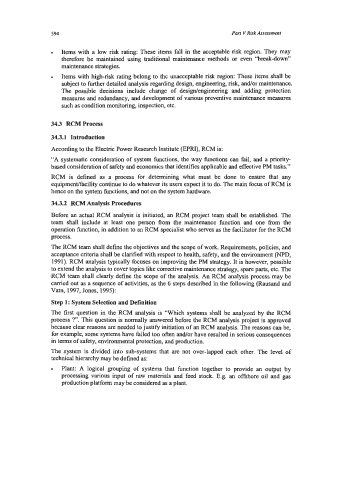Page 618 - Marine Structural Design
P. 618
594 Part V Rbk Assessment
Items with a low risk rating: These items fall in the acceptable risk region. They may
therefore be maintained using traditional maintenance methods or even ‘%reakdown”
maintenance strategies.
Items with high-risk rating belong to the unacceptable risk region: These items shall be
subject to further detailed analysis regarding design, engineering, risk, andor maintenance.
The possible decisions include change of desigdengineering and adding protection
measures and redundancy, and development of various preventive maintenance measures
such as condition monitoring, inspection, etc.
34.3 RCM Process
34.3.1 Introduction
According to the Electric Power Research Institute (EPRI), RCM is:
“A systematic consideration of system functions, the way functions can fail, and a priority-
based consideration of safety and economics that identifies applicable and effective PM tasks.”
RCM is defined as a process for determining what must be done to ensure that any
equipmentlfacility continue to do whatever its users expect it to do. The main focus of RCM is
hence on the system functions, and not on the system hardware.
34.3.2 RCM Analysis Procedures
Before an actual RCM analysis is initiated, an RCM project team shall be established. The
team shall include at least one person from the maintenance function and one fiom the
operation function, in addition to an RCM specialist who serves as the facilitator for the RCM
process.
The RCM team shall define the objectives and the scope of work. Requirements, policies, and
acceptance criteria shall be clarified with respect to health, safety, and the environment (NPD,
1991). RCM analysis typically focuses on improving the PM strategy. It is however, possible
to extend the analysis to cover topics like corrective maintenance strategy, spare parts, etc. The
RCM team shall clearly define the scope of the analysis. An RCM analysis process may be
carried out as a sequence of activities, as the 6 steps described in the following (Rausand and
Vatn, 1997, Jones, 1995):
Step 1: System Selection and Definition
The first question in the RCM analysis is ‘‘Which systems shall be analyzed by the RCM
process ?”. This question is normally answered before the RCM analysis project is approved
because clear reasons are needed to justify initiation of an RCM analysis. The reasons can be,
for example, some systems have failed too often andor have resulted in serious consequences
in terms of safety, environmental protection, and production.
The system is divided into sub-systems that are not over-lapped each other. The level of
technical hierarchy may be defined as:
Plant: A logical grouping of systems that function together to provide an output by
processing various input of raw materials and feed stock. E.g. an offbhore oil and gas
production platform may be considered as a plant.

